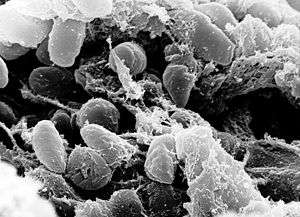Urban plague
| Urban plague | |
|---|---|
 | |
| A scanning electron microscope micrograph depicting a mass of Yersinia pestis bacteria in the foregut of an infected flea. | |
| Scientific classification | |
| Domain: | Bacteria |
| Kingdom: | Eubacteria |
| Phylum: | Proteobacteria |
| Class: | Gammaproteobacteria |
| Genus: | Yersinia |
| Species: | Y. pestis |
Urban plague is an infectious disease among rodent species that live in close association with humans in urban areas. It is caused by the bacterium Yersinia pestis which is the same bacterium that causes bubonic and pneumonic plague in humans. Plague was first introduced into the United States in 1900 by rat–infested steamships that had sailed from affected areas, mostly from Asia. Urban plague spread from urban rats to rural rodent species, especially among prairie dogs in the western United States.[1][2]
Vector reservoir
Common vectors for urban plague are house mice, black rats, and Norway rats.[3]
Transmission
Urban plague spreads via flea bites.
See also
References
- ↑ "A Plague Epizootic In The Black-Tailed Prairie Dog (Cynomys Ludovicianus)". Jwildlifedis.org. 2006-01-01. Retrieved 2013-07-28.
- ↑ "CDC - Maps & Statistics - Plague". Cdc.gov. 2013-04-23. Retrieved 2013-07-28.
- ↑ Cockrum, E. Lendell, Rabies, Lyme Diseases, Hanta Virus and other Animal-Borne Human Diseases in the United States and Canada. Fisher Books, Tucson, Arizona. 1997. Page 36.
External links
- Black Death on In Our Time at the BBC. (listen now)
- Black Death at BBC
This article is issued from Wikipedia - version of the 11/4/2016. The text is available under the Creative Commons Attribution/Share Alike but additional terms may apply for the media files.
